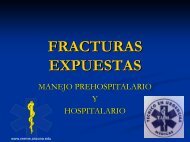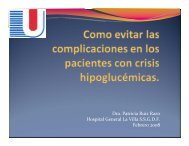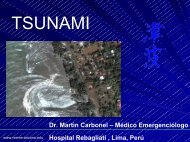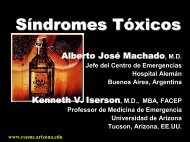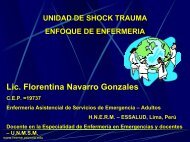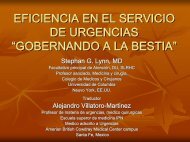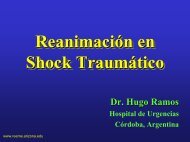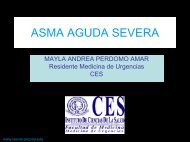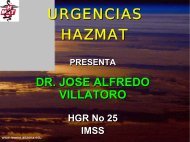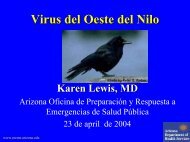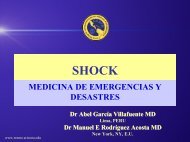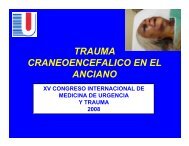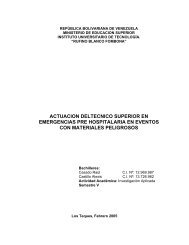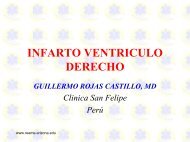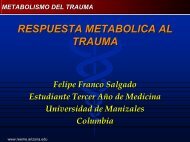RCP intrahospitalario - University of Arizona
RCP intrahospitalario - University of Arizona
RCP intrahospitalario - University of Arizona
You also want an ePaper? Increase the reach of your titles
YUMPU automatically turns print PDFs into web optimized ePapers that Google loves.
www.reeme.arizona.edu<br />
CONGRESO ECC 2005<br />
Reanimación Intrahospitalaria<br />
Dr. Augusto Maldonado G.<br />
EMERGENCIOLOGO<br />
Quito-Ecuador<br />
Bogota VII-2005
www.reeme.arizona.edu<br />
In-hospital cardiac arrest.<br />
Jastremski MS.<br />
Program for Multidisciplinary Critical Care, SUNY Health Science Center, Syracuse.<br />
Patients who suffer an in-hospital cardiac arrest represent a neglected and underutilized<br />
resource for resuscitation research. There exists an unwritten, but widely held, belief<br />
among resuscitation researchers that the in-hospital arrest population is unsuitable<br />
for resuscitation research because it is composed mostly <strong>of</strong> patients whose<br />
cardiac arrest is the terminal event <strong>of</strong> a fatal illness. Despite the large numbers <strong>of</strong><br />
hospitalized patients on whom cardiac resuscitation is attempted each year, there are few<br />
reports and even less true research devoted to this clinical problem. This article, which is<br />
intended to be provocative, reviews and summarizes the existing literature on inhospital<br />
resuscitation from cardiac arrest, considers the advantages <strong>of</strong><br />
resuscitation research in this setting, and concludes with a challenge to<br />
resuscitation researchers.<br />
Resuscitation. 1998 Oct-Nov;39(1-2):23-31.
Reanimación Intrahospitalaria<br />
Trabajos Publicados:<br />
• Busqueda de literatura médica:<br />
“in hospital cardiac arrest”<br />
• Aprox 300 artículos publicados sobre<br />
diversos tópicos de R.C.P.<br />
intrahospitalaria.<br />
• Análisis de los relevantes.<br />
www.reeme.arizona.edu
Reanimación Intrahospitalaria<br />
Criterios de estudio:<br />
• Pacientes con enfermedades<br />
terminales.<br />
PCR en SE.<br />
PCR en UCI.<br />
PCR en SO.<br />
www.reeme.arizona.edu
Reanimación Intrahospitalaria<br />
Criterios de estudio:<br />
• Pacientes con eventos súbitos,<br />
inesperados en los distintos servicios<br />
hospitalarios.<br />
• Monitoreados o no.<br />
• Con o sin signos y síntomas previos.<br />
• Tipo de paro: Respiratorio o cardíaco<br />
en su inicio.<br />
www.reeme.arizona.edu
Reanimación Intrahospitalaria<br />
• Factores Hospitalarios<br />
• Factores de los Pacientes<br />
• Factores de la R.C.P.<br />
www.reeme.arizona.edu
Reanimación Intrahospitalaria<br />
Factores Hospitalarios:<br />
• Instrucción en AVCA.<br />
• Disponibilidad de un equipo de<br />
reanimación hospitalaria.<br />
• Disponibilidad de desfibriladores.<br />
www.reeme.arizona.edu
Reanimación Intrahospitalaria<br />
INSTRUCCIÓN EN AVCA :<br />
• La formación de equipos de manejo de<br />
reanimación es fundamental.<br />
• El trabajo bajo esquemas y protocolos hace<br />
uniforme el reporte de datos y la conducción de<br />
estudios.<br />
• La experiencia de los operadores es primordial.<br />
• Los concensos internacionales obligan a<br />
actualizar a los equipos de <strong>RCP</strong> y a mantener un<br />
control de calidad aun cuando varias de sus<br />
recomendaciones no tengan validación<br />
prospectiva.<br />
www.reeme.arizona.edu
Characteristics and outcome among patients<br />
suffering from in hospital cardiac arrest in<br />
relation to whether the arrest took place during<br />
<strong>of</strong>fice hours.<br />
Herlitz J, Bang A, Alsen B, Aune S.<br />
“Among patients in whom the arrest took place during<br />
<strong>of</strong>fice hours (08:00-16:30 h) the overall survival rate was<br />
49% as compared with 26% among the remaining patients<br />
(P
Incidence, location and reasons for avoidable<br />
in-hospital cardiac arrest in a district general<br />
hospital.<br />
www.reeme.arizona.edu<br />
Hodgetts T, Kenward G, Vlackonikolis I, et al.<br />
“The majority <strong>of</strong> treated in-hospital cardiac arrests<br />
are potentially avoidable. Multiple system failures<br />
include delays and errors in diagnosis,<br />
inadequate interpretation <strong>of</strong> investigations,<br />
incomplete treatment, inexperienced doctors and<br />
mangement in inappropriate areas”<br />
Resuscitation. 2002 Aug; 54 (2):115-123.
Reanimación Intrahospitalaria<br />
Equipos de <strong>RCP</strong>:<br />
• El impacto en la sobrevida de pacientes es<br />
definitivo no solamente por los resultados de la<br />
<strong>RCP</strong> sino por la identificación de los pacientes en<br />
riesgo.<br />
www.reeme.arizona.edu
www.reeme.arizona.edu<br />
Effects <strong>of</strong> a medical emergency team on<br />
reduction <strong>of</strong> incidence and mortality from<br />
unexpected cardiac arrests in hospital:<br />
preliminary study.<br />
Michael D. Buist<br />
Comentario:<br />
“No es un ensayo clínico. Se analizan los ingresos en un<br />
hospital antes de instaurar grupo de Reanimación y posterior al<br />
mismo. El grupo de reanimación en el estudio, el papel<br />
fundamental que desarrolla es el de prevención de la parada<br />
previa identificación de los sujetos de riesgo.”<br />
“Por cada 1000 ingresos en un Hospital Terciario con equipo de<br />
resucitación vamos a evitar 1 parada cardiaca”<br />
BMJ 2002; 324: 387-390.
Evaluation <strong>of</strong> a hospital-wide resuscitation<br />
team: does it increase survival for in-hospital<br />
cardiopulmonary arrest?<br />
www.reeme.arizona.edu<br />
Sean O. Henderson<br />
Comentario:<br />
“No se trata de un ensayo clínico sino de un estudio<br />
observacional de tipo antes-después.<br />
Cuando analizan el número de altas tras parada, obtienen un<br />
NNT de 9, pero con un porcentaje de pérdidas del 30%.”<br />
“Por cada 5 paros cardiacos <strong>intrahospitalario</strong>s que se trate por<br />
equipo de reanimación específico se va a conseguir 1 caso de<br />
recuperación del ritmo ”<br />
Resuscitation 2001: 48; 111-116
Reanimación Intrahospitalaria<br />
Disponibilidad de desfibriladores:<br />
• Un porcentaje alto de pacientes que sufren PCR<br />
<strong>intrahospitalario</strong> tienen FV o TVSP como ritmo<br />
inicial.<br />
• El mejor pronóstico a corto y largo plazo tienen<br />
los pacientes que fueron reanimados de FV o<br />
TVSP.<br />
• Es indispensable contar con un desfibrilador<br />
convencional o DEA en las distintas áreas<br />
hospitalarias.<br />
www.reeme.arizona.edu
Preliminary in-hospital experience with<br />
a fully automatic external cardioverterdefibrillator<br />
André Moreira Bento, Luiz Francisco Cardoso, Sérgio<br />
Timerman, et al.<br />
“The AECD has the feasibility to combine long-term<br />
monitoring with automatic defibrillation safely and<br />
effectively. It presents the possibility <strong>of</strong> providing<br />
rapid identification <strong>of</strong>, and response to, in-hospital<br />
ventricular tachyarrhythmias”<br />
Resuscitation, Volume 63, Issue 1, October 2004<br />
www.reeme.arizona.edu
In hospital cardiac arrest: a role for<br />
automatic defibrillation.<br />
Cusnir H, Tongia R, Sheka KP, Kavesteen D, Segal RR,<br />
Nowakiwskyj VN, Cassera F, Scherer H, Costello D, Valerio L, Yens<br />
DP, Shani J, Hollander G.<br />
Division <strong>of</strong> Cardiology, Maimonides Medical Center, 953 49th Street,<br />
Brooklyn, NY 11219, USA.<br />
“The purpose <strong>of</strong> this study was to assess the potential impact <strong>of</strong><br />
in-hospital AECDs on the critical time to defibrillation in<br />
monitored hospital units.”<br />
“The use <strong>of</strong> AECDs on monitored units would significantly<br />
reduce the critical time to defibrillation in patients with SCA.<br />
We anticipate this would translate to improved survival rates,<br />
and better neurologic outcomes.”.<br />
Resuscitation. 2004 Sep;62(3):291-7.<br />
www.reeme.arizona.edu
Automated External Defibrillation Versus<br />
Manual Defibrillation for Prolonged Ventricular<br />
Fibrillation: Lethal Delays <strong>of</strong> Chest<br />
Compressions Before and After Countershocks<br />
Berg R, Hilwig R, Kern K, Sanders A, Xavier L, Ewi G.<br />
<strong>University</strong> <strong>of</strong> <strong>Arizona</strong><br />
www.reeme.arizona.edu<br />
“The longer delays in chest compressions<br />
with AED defibrillation versus manual<br />
defibrillation can worsen the outcome from<br />
prolonged ventricular fibrillation.”.<br />
Trabajo Experimental<br />
Ann Emerg Med. 2003; 42: 458-467.
Reanimación Intrahospitalaria<br />
Factores Pacientes:<br />
• Edad.<br />
• Enfermedades previas.<br />
• Tipo de P.C.R.<br />
• Presenciado o no.<br />
• Signos o síntomas previos.<br />
www.reeme.arizona.edu
Predictors <strong>of</strong> survival <strong>of</strong> in-hospital cardiac<br />
arrest.<br />
Lazzam C, McCans JL.<br />
Division <strong>of</strong> Cardiology, Sir Mortimer B Davis Jewish General Hospital,<br />
Montreal, Quebec.<br />
39% exitosos<br />
18% sobrevivieron<br />
www.reeme.arizona.edu<br />
< 75 años<br />
PCR con testigo<br />
< 48h de un evento isquémico
Evaluación de la resucitación<br />
cardiopulmonar y cerebral<br />
intrahospitalaria<br />
Dr. Reynol Rubiera Jiménez,1 Dr. Jaime Parellada Blanco,2 Dr. José<br />
SantosGracia,3 Dr. Vicente Río Vázquez,4 y Dr. Javier Joanes Fiol.<br />
www.reeme.arizona.edu Rev Cub Med Int y Emerg 2003;2(3): 31-43
Evaluación de la resucitación<br />
cardiopulmonar y cerebral<br />
intrahospitalaria<br />
Dr. Reynol Rubiera Jiménez,1 Dr. Jaime Parellada Blanco,2 Dr. José<br />
SantosGracia,3 Dr. Vicente Río Vázquez,4 y Dr. Javier Joanes Fiol.<br />
www.reeme.arizona.edu
Evaluación de la resucitación<br />
cardiopulmonar y cerebral<br />
intrahospitalaria<br />
Dr. Reynol Rubiera Jiménez,1 Dr. Jaime Parellada Blanco,2 Dr. José<br />
SantosGracia,3 Dr. Vicente Río Vázquez,4 y Dr. Javier Joanes Fiol.<br />
www.reeme.arizona.edu
A Comparison <strong>of</strong> Antecedents to Cardiac Arrests,<br />
Deaths and Emergency Intensive care Admissions in<br />
Austral. and N.Z.,and the U.K.<br />
The ACADEMIA study<br />
Juliane Kause a,1, Gary Smith b,., David Prytherch c, Michael Parr d,<br />
Arthas Flabouris d, Ken Hillman e<br />
www.reeme.arizona.edu<br />
Resuscitation 62 (2004) 275–282
% del total de eventos<br />
A Comparison <strong>of</strong> Antecedents to Cardiac Arrests,<br />
Deaths and Emergency Intensive care Admissions<br />
in Austral. and N.Z.,and the U.K.<br />
The ACADEMIA study<br />
Juliane Kause a,1, Gary Smith b,., David Prytherch c, Michael Parr d,<br />
Arthas Flabouris d, Ken Hillman e<br />
www.reeme.arizona.edu
% TTL<br />
15min hasta 24h<br />
A Comparison <strong>of</strong> Antecedents to Cardiac Arrests,<br />
Deaths and Emergency Intensive care Admissions<br />
in Austral. and N.Z.,and the U.K.<br />
The ACADEMIA study<br />
Juliane Kause a,1, Gary Smith b,., David Prytherch c, Michael Parr d,<br />
Arthas Flabouris d, Ken Hillman e<br />
www.reeme.arizona.edu
Anticipating events <strong>of</strong> in-hospital cardiac<br />
arrest.<br />
Berlot, Giorgio a; Pangher, Annamaria a; Petrucci,<br />
Lara a; Bussani, Rossana b; Lucangelo, Umberto a<br />
“Most in-hospital cardiac arrests are<br />
preceded by events that <strong>of</strong>ten go<br />
overlooked and whose correct<br />
interpretation could be associated with a<br />
reduced mortality rate.”<br />
www.reeme.arizona.edu<br />
European Journal <strong>of</strong> Emergency Medicine.<br />
11(1):24-28, February 2004.
Antecedentes antes de un Paro<br />
www.reeme.arizona.edu<br />
Cardíaco<br />
• Cerca de un 84% de los casos de paro<br />
cardíaco o respiratorio tienen<br />
antecedentes de eventos que son<br />
detectados por el personal de salud.<br />
• Se debería considerar un abordaje más<br />
agresivo una vez que se detectan los<br />
mismos.
Reanimación Intrahospitalaria<br />
Factores de la R.C.P.:<br />
• Ritmo de inicio.<br />
• Monitoreo previo o no.<br />
• Tiempo de inicio de la R.C.P.<br />
• Duración de la R.C.P. y tiempo de<br />
ROSC.<br />
www.reeme.arizona.edu
Cardiopulmonary resuscitation <strong>of</strong> adults in<br />
the hospital:<br />
A report <strong>of</strong> 14 720 cardiac arrests from the<br />
National Registry<br />
<strong>of</strong> Cardiopulmonary Resuscitation<br />
Mary Ann Peberdy *, William Kaye, Joseph P. Ornato, Gregory<br />
L. Larkin, Vinay Nadkarni, Mary Elizabeth Mancini, Robert A.<br />
Berg, Graham Nichol, Tanya Lane-Trultt, for the N<strong>RCP</strong>R<br />
Investigators<br />
www.reeme.arizona.edu
www.reeme.arizona.edu
Cardiopulmonary resuscitation <strong>of</strong> adults in<br />
the hospital: A report <strong>of</strong> 14 720 cardiac<br />
arrests from the National Registry<br />
<strong>of</strong> Cardiopulmonary Resuscitation<br />
Mary Ann Peberdy *, William Kaye, Joseph P. Ornato, Gregory<br />
L. Larkin, Vinay Nadkarni, Mary Elizabeth Mancini, Robert A.<br />
Berg, Graham Nichol, Tanya Lane-Trultt, for the N<strong>RCP</strong>R<br />
Investigators<br />
www.reeme.arizona.edu<br />
Resuscitation 58 (2003) 297/308
Evaluación de la resucitación<br />
cardiopulmonar y cerebral<br />
intrahospitalaria<br />
Dr. Reynol Rubiera Jiménez,1 Dr. Jaime Parellada Blanco,2 Dr.<br />
José SantosGracia,3 Dr. Vicente Río Vázquez,4 y Dr. Javier<br />
Joanes Fiol.<br />
www.reeme.arizona.edu
www.reeme.arizona.edu<br />
Monitoreo<br />
Mejora el resultado de la <strong>RCP</strong> por:<br />
• Permite un reconocimiento más rápido<br />
ritmos de PCR.<br />
• Ayuda a reconocer tempranamente<br />
arritmias peligrosas.<br />
• Acorta el tiempo evento-desfibrilación
In-hospital cardiac arrest: survival depends<br />
mainly on the effectiveness <strong>of</strong> the<br />
emergency response<br />
Claudio Sandroni a., Giorgia Ferro a, Susan Santangelo a, et.al.<br />
www.reeme.arizona.edu<br />
Resuscitation 62 (2004) 291–297
Evaluación de la resucitación<br />
cardiopulmonar y cerebral<br />
intrahospitalaria<br />
Dr. Reynol Rubiera Jiménez,1 Dr. Jaime Parellada Blanco,2 Dr.<br />
José SantosGracia,3 Dr. Vicente Río Vázquez,4 y Dr. Javier<br />
Joanes Fiol.<br />
www.reeme.arizona.edu
In-hospital cardiac arrest: survival depends<br />
mainly on the effectiveness <strong>of</strong> the<br />
emergency response<br />
Claudio Sandroni a., Giorgia Ferro a, Susan Santangelo a, et.al.<br />
www.reeme.arizona.edu<br />
Resuscitation 62 (2004) 291–297
EVALUACIÓN DE LA RESUCITACIÓN<br />
CARDIOPULMONAR Y CEREBRAL<br />
INTRAHOSPITALARIA<br />
Dr. Reynol Rubiera Jiménez,1 Dr. Jaime Parellada Blanco,2 Dr.<br />
José SantosGracia,3 Dr. Vicente Río Vázquez,4 y Dr. Javier<br />
Joanes Fiol.<br />
www.reeme.arizona.edu
EVALUACIÓN DE LA RESUCITACIÓN<br />
CARDIOPULMONAR Y CEREBRAL<br />
INTRAHOSPITALARIA<br />
Dr. Reynol Rubiera Jiménez,1 Dr. Jaime Parellada Blanco,2 Dr.<br />
José SantosGracia,3 Dr. Vicente Río Vázquez,4 y Dr. Javier<br />
Joanes Fiol.<br />
www.reeme.arizona.edu
Characteristics and outcome among<br />
patients suffering from in hospital cardiac<br />
arrest in relation to the interval between<br />
collapse and start <strong>of</strong> CPR.<br />
www.reeme.arizona.edu<br />
Herlitz J, Bang A, Alsen B, Aune S.<br />
“<strong>RCP</strong> iniciada < 1 min luego del colapso<br />
Tiene el doble de posibilidades de egresar del<br />
Hospital”<br />
Resuscitation. 2002 May;53(2):127-33.
Cardiopulmonary resuscitation <strong>of</strong> adults in<br />
the hospital:A report <strong>of</strong> 14 720 cardiac<br />
arrests from the National Registry<br />
<strong>of</strong> Cardiopulmonary Resuscitation<br />
Mary Ann Peberdy *, William Kaye, Joseph P. Ornato, et.al.<br />
www.reeme.arizona.edu
Very high survival among patients<br />
defibrillated at an early stage after inhospital<br />
ventricular fibrillation on wards<br />
withand without monitoring facilities<br />
Johan Herlitz., Soveig Aune, Angela B°ang, Martin Fredriksson,<br />
www.reeme.arizona.edu<br />
Ann-Britt Thor´en, Lars Ekstr¨om, Stig Holmberg<br />
“The proportion <strong>of</strong> patients found in VF was 59% on wards with<br />
monitoring facilities and 45% on wards without (p < 0.0001).<br />
Approximately 90% <strong>of</strong> these patients were defibrillated ≤3 min after<br />
collapse on monitored wards compared with 54% on non-monitored<br />
wards (p < 0.0001)”<br />
“On monitored wards, the survival was 63% if defibrillated ≤3 min<br />
compared with 60% if defibrillated >3 min after collapse (NS).<br />
The corresponding values for non-monitored wards were 72% and 35%,<br />
respectively (p = 0.0003)”<br />
Resuscitation xxx (2005) xxx–xxx
Very high survival among patients defibrillated<br />
at an early stage after in-hospital ventricular<br />
fibrillation on wards withand without monitoring<br />
facilities<br />
Johan Herlitz., Soveig Aune, Angela B°ang, Martin Fredriksson,<br />
www.reeme.arizona.edu<br />
Ann-Britt Thor´en, Lars Ekstr¨om, Stig Holmberg<br />
“If patients with in hospital VF were defibrillated early in both<br />
monitored and non monitored wards survival to hospital<br />
discharge was high. This highlights the importance <strong>of</strong> being<br />
prepared for the rapid defibrillation on wards without<br />
monitoring facilities”<br />
Resuscitation xxx (2005) xxx–xxx
Validation <strong>of</strong> a clinical decision aid<br />
to discontinue in-hospital cardiac<br />
arrest resuscitations.<br />
Van Walraven C, Forster AJ, Parish DC, Dane FC,<br />
Chandra KM, Durham MD, et al.<br />
www.reeme.arizona.edu<br />
JAMA 2001;285:1604.
Reanimación Intrahospitalaria<br />
Conclusiones 1:<br />
• Debe considerarse obligatoria técnica y<br />
éticamente la creación de equipos de<br />
<strong>RCP</strong> <strong>intrahospitalario</strong>s.<br />
• Disponer de infraestructura básica.<br />
• Protocolizar el manejo.<br />
www.reeme.arizona.edu
Reanimación Intrahospitalaria<br />
Conclusiones 2:<br />
• Identificar oportunamente los signos<br />
ominosos que pueden indicar la<br />
progresión de un paciente hacia un<br />
PCR.<br />
• Respuesta inmediata frente a un PCR.<br />
• Identificar rápida y eficientemente los<br />
ritmos.<br />
www.reeme.arizona.edu
Reanimación Intrahospitalaria<br />
Conclusiones 3:<br />
• Evaluar el costo beneficio de la <strong>RCP</strong> de<br />
acuerdo a las características de los<br />
pacientes.<br />
• Invertir en investigación hospitalaria<br />
con el fin de actuar en base a nuestras<br />
patologías.<br />
www.reeme.arizona.edu



